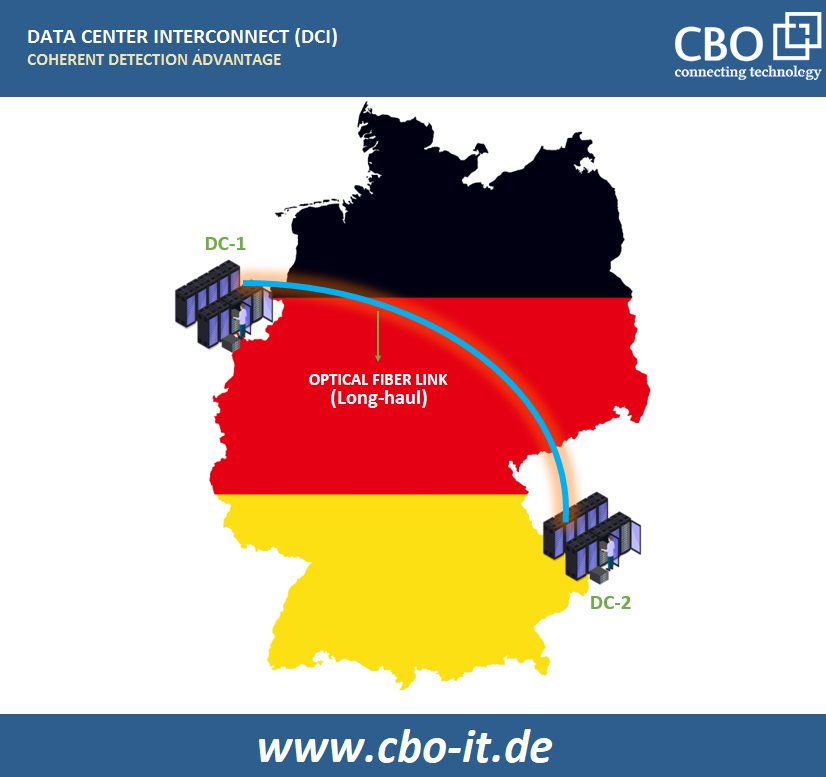A tremendous sum of data is managed, exchanged, and distributed across the globe these days. Data centers are growing in capacity and numbers and so does the requirement for their interconnectivity or data center interconnectivity (aka DCI). These days metro DCI infrastructure designers are engaged in a vigorous debate about direct detection and coherent detection – the two widely used modulation formats. Let us provide you with some crucial information on this subject!

Coherent Detection
Coherent detection is a technique used for the detection of optical signals. This modulation technique is useful for both optical measurement systems and optical fiber-based communication systems. Coherent detection utilizes a local oscillator at the receiver end and thus it enables the transmission of signals at 100Gbits/s over a single wavelength for long-haul DWDM type networks.
When configured to operate with coherent detection modulation, an optical receiver can keep track of the phase of an optical transmitter for extracting any frequency and phase information carried by a transmitted signal.
Here, it is important to be mentioned that coherent detection is a wireless communication system related concept but it works fine in optical fiber-based communications systems as well. Coherent detection has brought great advantages to long-haul optical networks. However, the high-power consumption and increased cost of coherent detection are a couple of big challenges for 100G metro DCI.
Direct Detection
Unlike coherent detection, a photo-detector operating indirect detection mode can only respond to the changes in the optical power of the signal it receives, and no information about the frequency or phase is obtained or resolved.
Direct detect networks are simpler than coherent networks, consume lesser power, and are cost-effective than the coherent detection-based networks. However, direct detection networks are nowhere near to the coherent ones when it comes to fiber capacity.
In today`s rapidly expanding network space direct detection networks are playing a vital role. The addition of PAM4 and PAM8 indicates that this technology is still in its evaluation phase and has a promising future ahead.
Direct Vs. Coherent Detection: Which One is Superior?
As we know that both direct detection and coherent detection can be used for data center interconnect via 100G links, so which one is a better choice? Let us proceed with a quick comparison between the performance of coherent and direct detection in various fields.
Fiber Capacity:
The coherent detection method can extract and resolve frequency, phase, and frequency related information from an optical carrier. Thus, it can offer much higher fiber capacity.
Complexity:
again, coherent detection is a clear winner in this department also. These connections are built through digital signal processors with an ability to compensate large polarization and chromatic mode dispersion without any additional hardware such as optical dispersion compensators and optical amplifiers. On the other hand, in direct detection networks hardware resources are utilized for the compensation of mode dispersion. Therefore, coherent networks by construction are far simpler than direct detection networks.
Cost:
Incoherent detection networks, application-specific DSPs, and integrated circuits are used, unlike direct detection networks. So, the deployment, operation, and maintenance of coherent detection networks are much higher than that of the direct detection networks. In other words, direct detection is comparatively cost-effective due to 100G transceivers and it is an attractive option in terms of cost.
Power Consumption:
As we have mentioned above, additional hardware and optoelectrical components along with DSPs are used in the construction of coherent detection networks. That’s why these networks do not only have a greater upfront cost but are also more power-consuming one comparatively. On the other hand, direct detection networks do not contain power-hungry DSPs (digital signal processors) and that’s why they consume less power than coherent detection networks.
Link Distances:
Well, in this department coherent detection is way more superior to the direct detection networks. Coherent detection networks can be built for signal transmission over links stretched over thousands of kilometers. However, a maximum distance of up to 80 kilometers is possible when we go with direction detection.
Conclusion
- Coherent detection is a costlier but very efficient and reliable technology available for DCI applications
- Direct detection is also in great demand and emerging as a viable and most practical solution for metro level DCI
- DCI network engineers and designers should avoid coherent detection wherever direct detection technology can fulfill their requirements.
 English
English
 Deutsch
Deutsch
 Espaniol
Espaniol










